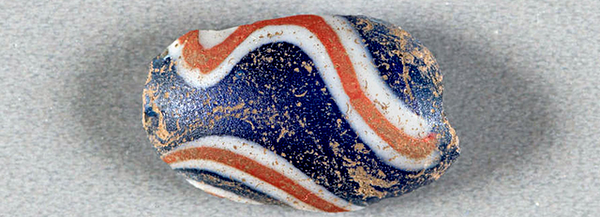- By Lindsey Hadlock
- Around Town
 Print
Print  A glass bead found among other artifacts at two historical locations near Geneva, New York. Photo by Cornell University Library
A glass bead found among other artifacts at two historical locations near Geneva, New York. Photo by Cornell University LibraryUnearthed, digitized and soon to be repatriated, artifacts from two Native American towns near Geneva, New York are beginning to share their rich stories online through a collaborative project by anthropologists, librarians and Indigenous community members.
The recently launched digital collection – Onöndowa'ga:' (Seneca) Haudenosaunee Archaeological Materials, circa 1688-1754 – features two historical locations, White Springs and Townley-Read, which were inhabited by members of the Onöndowa'ga:' (Seneca) Haudenosaunee (Six Nations Iroquois) after they fled the French military destruction of the town of Ganondagan in 1687.
Various cultural artifacts and the changing layout of the towns show how the communities adapted and thrived in their new environments, according to Kurt Jordan, Cornell University anthropology professor and director of the American Indian and Indigenous Studies Program. Jordan led archaeological work at the two locations.
"There's a misconception common among scholars until recently that, as soon as Europeans arrived, Native people went on a long, slow slide into disappearing and irrelevance," he said. "But you can really see that there is a ton of Native technology and local plant and animal species that were being used alongside European imports."
The project will also physically reunite descendant communities with their heritage objects when the original physical artifacts are transferred from Cornell's Department of Anthropology to the Seneca-Iroquois National Museum in Salamanca, New York. The transfer of materials is scheduled to start next summer.
"Bringing the materials back empowers the Seneca community," said Joe Stahlman, director of the museum and a consultant on the project. "This becomes an opportunity for the Seneca to contribute to the research but also to show themselves as knowledge holders."
v16i38



